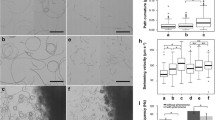Abstract
Gel filtration on highly cross-linked molecular sieves of the sperm attractants of some hydromedusae revealed that the active agents differ in their molecular weights. These differences fall roughly along taxonomic lines, at least at the order level. Anthomedusae have attractants with molecular weights greater than 5,000, while the Leptomedusae attractants have weights less than 1,000. The Limnomedusae and Trachymedusae attractants have weights above 5,000. All the attractants are heat-stable, but only those of the Leptomedusae can pass across a dialysis membrane with a molecular weight cut-off of 14,000.
Similar content being viewed by others
Literature Cited
Cavanaugh, G.M. (Ed.): Formulae and methods V of the Marine Biological Laboratory chemical room; 87 pp. Woods Hole, Mass.: Marine Biological Laboratory 1956
Eaker, D. and J. Porath: Sorption effects in gel filtration: A survey of amino acid behavior on Sephadex G-10. Separation Sci. 2, 507–550 (1967)
Hartlaub, C.: Craspedote Medusen. Nord. Plankt. 12, 237–363 (1913)
Hyman, L.H.: The invertebrates. I: Protozoa through Ctenophora, 726 pp. New York: McGraw-Hill 1940
Lenhoff, H.M.: On the mechanism of action and evolution of receptors associated with feeding and digestion. In: Coelenterate biology, reviews and new perspectives, pp 211–243. Ed. by L. Muscatine and H.M. Lenhoff, New York: Academic Press 1974
Miller, R.L.: Chemotaxis during fertilization in the hydroid, Campanularia. J. exp. Zool. 162, 23–44 (1966)
— Gel filtration of the sperm attractants of some marine Hydrozoa. J. exp. Zool. 182, 281–298 (1972)
— Chemotaxis of the spermatozoa of Ciona intestinalis. Nature, Lond. 254, 244–245 (1975)
— Site specific sperm agglutination and the timed release of a sperm chemoattractant by the egg of the leptomedusan Orthopyxis caliculata. J. exp. Zool. 205, 385–392 (1978)
— Sperm chemotaxis in the hydromedusae. I. Species-specificity and sperm behavior. Mar. Biol. 53, 99–114 (1979)
— and C.Y. Tseng: Properties and partial purification of the sperm attractant of Tubularia. Am. Zool. 14, 467–486 (1974)
Minganti, A.: Experienze sulle fertilizine nelle ascidie. Pubbl. Staz. zool. Napoli 23, 58–65 (1951)
Russell, F.S.: The Medusae of the British Isles. Anthomedusae, Leptomedusae, Limnomedusae, Trachymedusae and Narcomedusae, 530 pp. Cambridge, England: Cambridge University Press 1953
Stern, S.: Physical and chemical comparisons of univalent and multivalent sea urchin fertilizins. Biol. Bull. mar. biol. Lab., Woods Hole 133, 255–269 (1967)
— and C.B. Metz: Electrophoresis of sperm-absorbed univalent and multivalent sea urchin fertilizin. Expl Cell Res. 48, 224–226 (1967)
Tyler, A. and B. Tyler: The gametes; some procedures and properties, and physiology of fertilization and early development. In: Physiology of Echinodermata, pp 639–743. Ed. by R.A. Boolootian. New York: John Wiley Interscience 1966
Author information
Authors and Affiliations
Additional information
Communicated by M.R. Tripp, Newark
Rights and permissions
About this article
Cite this article
Miller, R.L. Sperm chemotaxis in the hydromedusae. II. Some chemical properties of the sperm attractants. Marine Biology 53, 115–124 (1979). https://doi.org/10.1007/BF00389183
Accepted:
Issue Date:
DOI: https://doi.org/10.1007/BF00389183




